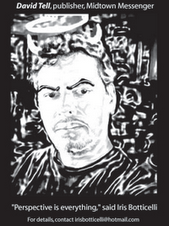'Copper Square's' not good enough?
As in an old fairy tale, maybe Arizona's urban "heart" is made of flint — easily cracked if too much feeling wells up
Perhaps to try to make up for one of its editors recently disputing the validity of the designation “Midtown,” the Arizona Republic a couple of weeks ago had one of its reporters cover efforts to brand—or re-brand—downtown Phoenix. Apparently “Copper Square,” the branding for 90 blocks of shops, hotels restaurants and sports and entertainment venues in the city’s core, has lost its luster, so Downtown Phoenix Partnership, always busily trying to justify the special assessment monies it receives from those constituents, has been working recently on a new campaign.
Reporter Jahna Berry, in the March 2 cover story, also noted that Phoenix is not a pioneer in this kind of effort. She pointed out that Las Vegas, Austin and Omaha—home of iconic tourist draws Warren Buffett, Mutual of Omaha and the fictional “Schmidt” of Alexander Payne’s film “About Schmidt” (predecessor to “Sideways,” his homage to the lesser winemaking areas of California) have also embarked on similar branding efforts. Berry cited these facts as evidence of success in that kind of effort: A 5 percent increase in visitors to Vegas over eight years, or 0.625 percent per year (which, to be generous, was about the same as the rate of population growth in developed countries during this period of an especially weak U.S. dollar—a boon to foreign tourists); a purely anecdotal testament to Austin’s unique live music culture, which may be found there “in some unlikely places”; and the city of Omaha’s own embrace of its new slogan, “O! so surprising.” (What may not be so surprising is that would-be tourists hearing of the slogan assume it refers to O!klahoma, and later need rescuing from mazes in fields of corn as high as an elephant’s eye, where they get lost seeking that state’s urban heart, memorialized in Neil Young’s ballad “The Last Trip to Tulsa.”)
Officials at DPP and representatives of other stakeholders were encouraged in their efforts to rebrand central Phoenix with the phrase, “Arizona’s Urban Heart,” based on surveys they did of East Asian tourists planning the itinerary of their U.S. visit. Leon Wong of Hong Kong, once a champion at ping pong before his early retirement following his college days, was already bringing his family to America for two-week vacation this spring. When he heard of the opportunity to include Arizona’s “urban heart” in the tour, he was quite excited. “But Daddy,” said his youngest daughter Peony, “I thought the Grand Canyon was the place to see in Arizona!” “Ah, but I see here in central Phoenix, they have the Grand Canal,” Leon assured her. “Plus, there’s a brand new city hotel, where we might get to meet other fascinating out-of-towners, like conventioneers!” he enthused.
“But what about the Painted Desert?” protested Leon Jr. “Well, according to an item I saw on a blog about Phoenix—I mean, ‘Arizona’s Urban Heart’—that I found, the Drop In Center (made possible with the collaboration of Native Health and Southwest Center for HIV/AIDS, and which provides youth ages 14 to 24 the opportunity to find jobs, get information and resources, meet with a life-coach, get involved in their community, and empower themselves to be better individuals in a safe environment) got a Fresh Coat of Paint recently,” said Leon, tentatively.
In addition to providing a low-key alternative to the crowds one has to elbow one’s way through for a glimpse at Arizona’s scenic wonders, taking in Arizona’s Urban Heart affords demographers and city planners, not mention regular urban appreciators of all sorts from around the world a thorough opportunity to take in a large and unspectacular urban area in a very specific—and special—stalled state of development, said Jim Flynn, DPP’s director of marketing. “You could visit many other cities—Boston, Chicago, Seattle, Atlanta, Washington, Charleston, St. Louis, Nashville, Dallas, San Diego ... even Omaha—for a sampling of a more mature, culturally vibrant American city. But only here in Phoenix can you find quite this precise mix of endless, near-identical strip malls, sporadic high-rise developments punctuating big-box retail and dining attractions, and dusty undeveloped lots in prime areas--all with a most amazing lack of shade and other pedestrian amenities conducive to the comfort of tourists, who would usually explore these phenomena close up, on foot.”
Plus, Flynn said, the city has perhaps the best preserved, most extensive—and youngest—officially designated historic residential neighborhoods, with dozens of styles ranging from Southwestern to Bungalow. “Isn’t saying the city has the youngest historic neighborhoods a little like saying someone is the world’s tallest dwarf?” asked Comedy Central’s vertically challenged Jon Stewart, upon hearing of the new pitch for Phoenix. “Well, I’m from Austin, and, as far as historic goes, well ... here I am,” said city Historic Preservation Officer Barbara Stocklin. “For now.”
Speaking of heart, “Arizona’s Urban Heart” takes on an entirely new meaning when you consider that between City Hall, the Legislature and even the state’s Congressional delegation, the city may have among the highest proportion of gay, lesbian and bisexual politicians anywhere! San Francisco’s Castro District, eat your urban heart out! (Even if you do have Rice-a-Roni, as part of your branding, keeping tourists coming back for seconds.—Wait—San Francisco’s part of Rice-a-Roni’s branding. Never mind.)
—David Tell
Subscribe to:
Post Comments (Atom)



1 comment:
So what does this mean? Is the DPP good? What does the future of downtown Phoenix look like?
Post a Comment